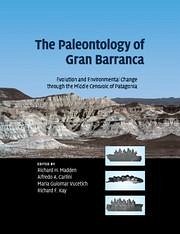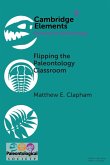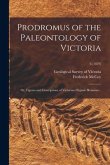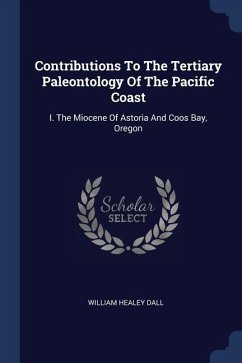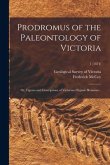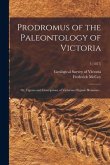The Paleontology of Gran Barranca
Herausgeber: Madden, Richard; Vucetich, Maria Guiomar; Carlini, Alfredo
The Paleontology of Gran Barranca
Herausgeber: Madden, Richard; Vucetich, Maria Guiomar; Carlini, Alfredo
- Broschiertes Buch
- Merkliste
- Auf die Merkliste
- Bewerten Bewerten
- Teilen
- Produkt teilen
- Produkterinnerung
- Produkterinnerung
A wealth of new information on the diversity, evolution and geochronology of the uniquely complete fossil record of Gran Barranca.
Andere Kunden interessierten sich auch für
![Flipping the Paleontology Classroom Flipping the Paleontology Classroom]() Matthew E. ClaphamFlipping the Paleontology Classroom22,99 €
Matthew E. ClaphamFlipping the Paleontology Classroom22,99 €![Prodromus of the Paleontology of Victoria; or, Figures and Descriptions of Victorian Organic Remains ..; 6 (1879) Prodromus of the Paleontology of Victoria; or, Figures and Descriptions of Victorian Organic Remains ..; 6 (1879)]() Frederick MccoyProdromus of the Paleontology of Victoria; or, Figures and Descriptions of Victorian Organic Remains ..; 6 (1879)15,99 €
Frederick MccoyProdromus of the Paleontology of Victoria; or, Figures and Descriptions of Victorian Organic Remains ..; 6 (1879)15,99 €![Man in Search of His Ancestors; the Romance of Paleontology Man in Search of His Ancestors; the Romance of Paleontology]() André SenetMan in Search of His Ancestors; the Romance of Paleontology22,99 €
André SenetMan in Search of His Ancestors; the Romance of Paleontology22,99 €![Contributions To The Tertiary Paleontology Of The Pacific Coast Contributions To The Tertiary Paleontology Of The Pacific Coast]() William Healey DallContributions To The Tertiary Paleontology Of The Pacific Coast22,99 €
William Healey DallContributions To The Tertiary Paleontology Of The Pacific Coast22,99 €![Prodromus of the Paleontology of Victoria; or, Figures and Descriptions of Victorian Organic Remains ..; 1 (1874) Prodromus of the Paleontology of Victoria; or, Figures and Descriptions of Victorian Organic Remains ..; 1 (1874)]() Frederick MccoyProdromus of the Paleontology of Victoria; or, Figures and Descriptions of Victorian Organic Remains ..; 1 (1874)17,99 €
Frederick MccoyProdromus of the Paleontology of Victoria; or, Figures and Descriptions of Victorian Organic Remains ..; 1 (1874)17,99 €![Prodromus of the Paleontology of Victoria; or, Figures and Descriptions of Victorian Organic Remains ..; 5 (1877) Prodromus of the Paleontology of Victoria; or, Figures and Descriptions of Victorian Organic Remains ..; 5 (1877)]() Frederick MccoyProdromus of the Paleontology of Victoria; or, Figures and Descriptions of Victorian Organic Remains ..; 5 (1877)15,99 €
Frederick MccoyProdromus of the Paleontology of Victoria; or, Figures and Descriptions of Victorian Organic Remains ..; 5 (1877)15,99 €![A Bibliography to the Paleontology of Massachusetts, 1821-1849, A Bibliography to the Paleontology of Massachusetts, 1821-1849,]() Warren I JohanssonA Bibliography to the Paleontology of Massachusetts, 1821-1849,14,99 €
Warren I JohanssonA Bibliography to the Paleontology of Massachusetts, 1821-1849,14,99 €-
-
-
A wealth of new information on the diversity, evolution and geochronology of the uniquely complete fossil record of Gran Barranca.
Produktdetails
- Produktdetails
- Verlag: Cambridge University Press
- Seitenzahl: 458
- Erscheinungstermin: 1. März 2018
- Englisch
- Abmessung: 279mm x 216mm x 24mm
- Gewicht: 1057g
- ISBN-13: 9781108445733
- ISBN-10: 110844573X
- Artikelnr.: 49442123
- Herstellerkennzeichnung
- Libri GmbH
- Europaallee 1
- 36244 Bad Hersfeld
- gpsr@libri.de
- Verlag: Cambridge University Press
- Seitenzahl: 458
- Erscheinungstermin: 1. März 2018
- Englisch
- Abmessung: 279mm x 216mm x 24mm
- Gewicht: 1057g
- ISBN-13: 9781108445733
- ISBN-10: 110844573X
- Artikelnr.: 49442123
- Herstellerkennzeichnung
- Libri GmbH
- Europaallee 1
- 36244 Bad Hersfeld
- gpsr@libri.de
Preface; List of contributors; 1. Notes toward a history of vertebrate
paleontology at Gran Barranca; Part I. Geology: 2. Physical stratigraphy of
the Sarmiento Formation (middle Eocene - lower Miocene) at Gran Barranca,
central Patagonia; 3. Paleomagnetism and magnetostratigraphy of the
Sarmiento Formation (Eocene-Miocene) at Gran Barranca, Chubut, Argentina;
4. A geochronology for the Sarmiento Formation at Gran Barranca; Part II.
Systematic Palaeontology: 5. Middle Eocene - Oligocene gastropods of the
Sarmiento Formation, central Patagonia; 6. Middle Tertiary marsupials from
central Patagonia (early Oligocene of Gran Barranca): understanding South
America's Grande Coupure; 7. Middle Eocene - Early Miocene Dasypodidae
(Xenarthra) of southern South America: biostratigraphy and palaeoecology;
8. The 'Condylarth' Didolodontidae from Gran Barranca: history of the
bunodont South American mammals until the Eocene-Oligocene transition; 9.
The Notohippidae (Mammalia, Notoungulata) from Gran Barranca: preliminary
considerations; 10. Rodent-like notoungulates (Typotheria) from Gran
Barranca, Chubut Province, Argentina: phylogeny and systematics; 11. The
Leontiniidae (Mammalia, Notoungulata) from the Sarmiento Formation at Gran
Barranca, Chubut Province, Argentina; 12. Colhuehuapian Astrapotheriidae
(Mammalia) from Gran Barranca south of Lake Colhue Huapi; 13. The rodents
from La Cantera and the early evolution of caviomorphs in South America;
14. Colhuehuapian rodents from Gran Barranca and other Patagonian
localities: the state of the art; 15. A new primate from the early Miocene
of Gran Barranca, Chubut Province, Argentina: paleoecological implications;
16. Bats (Mammalia: Chiroptera) from Gran Barranca (early Miocene,
Colhuehuapian), Chubut Province, Argentina; Part III. Patterns of Evolution
and Environmental Change: 17. The Mustersan age at Gran Barranca: a review;
18. A new mammal fauna at the top of the Gran Barranca sequence and its
biochronological significance; 19. Loessic and fluvial sedimentation in
Sarmiento Formation pyroclastics,middle Cenozoic of central Patagonia; 20.
Paleosols of the Middle Cenozoic Sarmiento Formation, central Patagonia;
21. Ichnofacies analysis of the Sarmiento Formation (middle Eocene-early
Miocene) at Gran Barranca, central Patagonia; 22. Phytolith studies in Gran
Barranca (central Patagonia, Argentina), the middle-late Eocene; 23. Stable
isotopes of fossil teeth and bones at Gran Barranca as a monitor of climate
change and tectonics; 24. Hypsodonty and body size in rodent like
notoungulates; Part IV. Regional Applications: 25. Vegetation during the
Eocene-Miocene interval in central Patagonia: a context of mammal
evolution; 26. Paleogene climatic and biotic events in the terrestrial
record of the Antarctic Peninsula: an overview; 27. Mid-Cenozoic
palaeoclimatic and palaeoceanographic trends in the southwestern Atlantic
basins, a dinoflagellate view; 28. Divisaderan land mammal age or local
fauna?; Part V. Summary: 29. Gran Barranca: a twenty-three million year
record of Middle-Cenozoic faunal evolution in Patagonia; Index.
paleontology at Gran Barranca; Part I. Geology: 2. Physical stratigraphy of
the Sarmiento Formation (middle Eocene - lower Miocene) at Gran Barranca,
central Patagonia; 3. Paleomagnetism and magnetostratigraphy of the
Sarmiento Formation (Eocene-Miocene) at Gran Barranca, Chubut, Argentina;
4. A geochronology for the Sarmiento Formation at Gran Barranca; Part II.
Systematic Palaeontology: 5. Middle Eocene - Oligocene gastropods of the
Sarmiento Formation, central Patagonia; 6. Middle Tertiary marsupials from
central Patagonia (early Oligocene of Gran Barranca): understanding South
America's Grande Coupure; 7. Middle Eocene - Early Miocene Dasypodidae
(Xenarthra) of southern South America: biostratigraphy and palaeoecology;
8. The 'Condylarth' Didolodontidae from Gran Barranca: history of the
bunodont South American mammals until the Eocene-Oligocene transition; 9.
The Notohippidae (Mammalia, Notoungulata) from Gran Barranca: preliminary
considerations; 10. Rodent-like notoungulates (Typotheria) from Gran
Barranca, Chubut Province, Argentina: phylogeny and systematics; 11. The
Leontiniidae (Mammalia, Notoungulata) from the Sarmiento Formation at Gran
Barranca, Chubut Province, Argentina; 12. Colhuehuapian Astrapotheriidae
(Mammalia) from Gran Barranca south of Lake Colhue Huapi; 13. The rodents
from La Cantera and the early evolution of caviomorphs in South America;
14. Colhuehuapian rodents from Gran Barranca and other Patagonian
localities: the state of the art; 15. A new primate from the early Miocene
of Gran Barranca, Chubut Province, Argentina: paleoecological implications;
16. Bats (Mammalia: Chiroptera) from Gran Barranca (early Miocene,
Colhuehuapian), Chubut Province, Argentina; Part III. Patterns of Evolution
and Environmental Change: 17. The Mustersan age at Gran Barranca: a review;
18. A new mammal fauna at the top of the Gran Barranca sequence and its
biochronological significance; 19. Loessic and fluvial sedimentation in
Sarmiento Formation pyroclastics,middle Cenozoic of central Patagonia; 20.
Paleosols of the Middle Cenozoic Sarmiento Formation, central Patagonia;
21. Ichnofacies analysis of the Sarmiento Formation (middle Eocene-early
Miocene) at Gran Barranca, central Patagonia; 22. Phytolith studies in Gran
Barranca (central Patagonia, Argentina), the middle-late Eocene; 23. Stable
isotopes of fossil teeth and bones at Gran Barranca as a monitor of climate
change and tectonics; 24. Hypsodonty and body size in rodent like
notoungulates; Part IV. Regional Applications: 25. Vegetation during the
Eocene-Miocene interval in central Patagonia: a context of mammal
evolution; 26. Paleogene climatic and biotic events in the terrestrial
record of the Antarctic Peninsula: an overview; 27. Mid-Cenozoic
palaeoclimatic and palaeoceanographic trends in the southwestern Atlantic
basins, a dinoflagellate view; 28. Divisaderan land mammal age or local
fauna?; Part V. Summary: 29. Gran Barranca: a twenty-three million year
record of Middle-Cenozoic faunal evolution in Patagonia; Index.
Preface; List of contributors; 1. Notes toward a history of vertebrate
paleontology at Gran Barranca; Part I. Geology: 2. Physical stratigraphy of
the Sarmiento Formation (middle Eocene - lower Miocene) at Gran Barranca,
central Patagonia; 3. Paleomagnetism and magnetostratigraphy of the
Sarmiento Formation (Eocene-Miocene) at Gran Barranca, Chubut, Argentina;
4. A geochronology for the Sarmiento Formation at Gran Barranca; Part II.
Systematic Palaeontology: 5. Middle Eocene - Oligocene gastropods of the
Sarmiento Formation, central Patagonia; 6. Middle Tertiary marsupials from
central Patagonia (early Oligocene of Gran Barranca): understanding South
America's Grande Coupure; 7. Middle Eocene - Early Miocene Dasypodidae
(Xenarthra) of southern South America: biostratigraphy and palaeoecology;
8. The 'Condylarth' Didolodontidae from Gran Barranca: history of the
bunodont South American mammals until the Eocene-Oligocene transition; 9.
The Notohippidae (Mammalia, Notoungulata) from Gran Barranca: preliminary
considerations; 10. Rodent-like notoungulates (Typotheria) from Gran
Barranca, Chubut Province, Argentina: phylogeny and systematics; 11. The
Leontiniidae (Mammalia, Notoungulata) from the Sarmiento Formation at Gran
Barranca, Chubut Province, Argentina; 12. Colhuehuapian Astrapotheriidae
(Mammalia) from Gran Barranca south of Lake Colhue Huapi; 13. The rodents
from La Cantera and the early evolution of caviomorphs in South America;
14. Colhuehuapian rodents from Gran Barranca and other Patagonian
localities: the state of the art; 15. A new primate from the early Miocene
of Gran Barranca, Chubut Province, Argentina: paleoecological implications;
16. Bats (Mammalia: Chiroptera) from Gran Barranca (early Miocene,
Colhuehuapian), Chubut Province, Argentina; Part III. Patterns of Evolution
and Environmental Change: 17. The Mustersan age at Gran Barranca: a review;
18. A new mammal fauna at the top of the Gran Barranca sequence and its
biochronological significance; 19. Loessic and fluvial sedimentation in
Sarmiento Formation pyroclastics,middle Cenozoic of central Patagonia; 20.
Paleosols of the Middle Cenozoic Sarmiento Formation, central Patagonia;
21. Ichnofacies analysis of the Sarmiento Formation (middle Eocene-early
Miocene) at Gran Barranca, central Patagonia; 22. Phytolith studies in Gran
Barranca (central Patagonia, Argentina), the middle-late Eocene; 23. Stable
isotopes of fossil teeth and bones at Gran Barranca as a monitor of climate
change and tectonics; 24. Hypsodonty and body size in rodent like
notoungulates; Part IV. Regional Applications: 25. Vegetation during the
Eocene-Miocene interval in central Patagonia: a context of mammal
evolution; 26. Paleogene climatic and biotic events in the terrestrial
record of the Antarctic Peninsula: an overview; 27. Mid-Cenozoic
palaeoclimatic and palaeoceanographic trends in the southwestern Atlantic
basins, a dinoflagellate view; 28. Divisaderan land mammal age or local
fauna?; Part V. Summary: 29. Gran Barranca: a twenty-three million year
record of Middle-Cenozoic faunal evolution in Patagonia; Index.
paleontology at Gran Barranca; Part I. Geology: 2. Physical stratigraphy of
the Sarmiento Formation (middle Eocene - lower Miocene) at Gran Barranca,
central Patagonia; 3. Paleomagnetism and magnetostratigraphy of the
Sarmiento Formation (Eocene-Miocene) at Gran Barranca, Chubut, Argentina;
4. A geochronology for the Sarmiento Formation at Gran Barranca; Part II.
Systematic Palaeontology: 5. Middle Eocene - Oligocene gastropods of the
Sarmiento Formation, central Patagonia; 6. Middle Tertiary marsupials from
central Patagonia (early Oligocene of Gran Barranca): understanding South
America's Grande Coupure; 7. Middle Eocene - Early Miocene Dasypodidae
(Xenarthra) of southern South America: biostratigraphy and palaeoecology;
8. The 'Condylarth' Didolodontidae from Gran Barranca: history of the
bunodont South American mammals until the Eocene-Oligocene transition; 9.
The Notohippidae (Mammalia, Notoungulata) from Gran Barranca: preliminary
considerations; 10. Rodent-like notoungulates (Typotheria) from Gran
Barranca, Chubut Province, Argentina: phylogeny and systematics; 11. The
Leontiniidae (Mammalia, Notoungulata) from the Sarmiento Formation at Gran
Barranca, Chubut Province, Argentina; 12. Colhuehuapian Astrapotheriidae
(Mammalia) from Gran Barranca south of Lake Colhue Huapi; 13. The rodents
from La Cantera and the early evolution of caviomorphs in South America;
14. Colhuehuapian rodents from Gran Barranca and other Patagonian
localities: the state of the art; 15. A new primate from the early Miocene
of Gran Barranca, Chubut Province, Argentina: paleoecological implications;
16. Bats (Mammalia: Chiroptera) from Gran Barranca (early Miocene,
Colhuehuapian), Chubut Province, Argentina; Part III. Patterns of Evolution
and Environmental Change: 17. The Mustersan age at Gran Barranca: a review;
18. A new mammal fauna at the top of the Gran Barranca sequence and its
biochronological significance; 19. Loessic and fluvial sedimentation in
Sarmiento Formation pyroclastics,middle Cenozoic of central Patagonia; 20.
Paleosols of the Middle Cenozoic Sarmiento Formation, central Patagonia;
21. Ichnofacies analysis of the Sarmiento Formation (middle Eocene-early
Miocene) at Gran Barranca, central Patagonia; 22. Phytolith studies in Gran
Barranca (central Patagonia, Argentina), the middle-late Eocene; 23. Stable
isotopes of fossil teeth and bones at Gran Barranca as a monitor of climate
change and tectonics; 24. Hypsodonty and body size in rodent like
notoungulates; Part IV. Regional Applications: 25. Vegetation during the
Eocene-Miocene interval in central Patagonia: a context of mammal
evolution; 26. Paleogene climatic and biotic events in the terrestrial
record of the Antarctic Peninsula: an overview; 27. Mid-Cenozoic
palaeoclimatic and palaeoceanographic trends in the southwestern Atlantic
basins, a dinoflagellate view; 28. Divisaderan land mammal age or local
fauna?; Part V. Summary: 29. Gran Barranca: a twenty-three million year
record of Middle-Cenozoic faunal evolution in Patagonia; Index.

